Saturday Review: A Measured Look at the M-chip and the New MacBook Pro Computers
By Graham K. Rogers

Apple's event this week demonstrated how work is continuing on the M-series chips. There is a clear indication that future iterations are likely to be far more powerful. The new 14" and 16" Macs also sent a message that these are not cosmetic devices. They are intended for serious work. Each has a number of expansion options so the right device for the job can be made available at a price
I did not watch Apple's Unleashed event live: past my bedtime. I set aside some time on Monday, but was only slightly moved by it all. I was suitably impressed by the evolution of the Apple silicon of course and by the updated MacBook Pro computers that we knew were coming. However, Apple told us in outline terms last year that there would be such changes and the rumors spoiled the surprise. There was a sort of bland inevitability about the whole thing.

Home Pod mini and the new colors - Image courtesy of Apple
As usual the event started with an overview by ringmaster, Tim Cook apparently banished to the gardens. I was underwhelmed by the initial announcements on a Siri-controlled Apple Music and the new HomePods with (I accept) a nice range of colors, but these have not been, and are unlikely to be available in Thailand along with any services that are Siri-based. An Apple TV for example, which costs far more here because of extra taxation, is missing Siri. Although generally Apple prices are on a par with the USA, there is a clear lack of services, thus diluting the Apple experience here; and devices are rarely available here at the same time as elsewhere.

M1 Pro chip - Image courtesy of Apple
What I really wanted to hear about was the new Macs. I was not disappointed when John Ternus and the team began by outlining the new Apple silicon: M1 Pro and M1 Max, putting all those rumors about M2 and M1-X to bed right away. The 14" and 16" MacBook Pro devices these chips go in (the M1 Max is a 23,000 baht option for the basic 14" MacBook Pro) have been updated with more ports, SD card reader and HDMI 2 (not the latest 2.1), but have lost the TouchBar for - big breath for marketing - larger Function keys. I am among an apparent minority who will miss the TouchBar which I always use when working on my current M1 Mac.
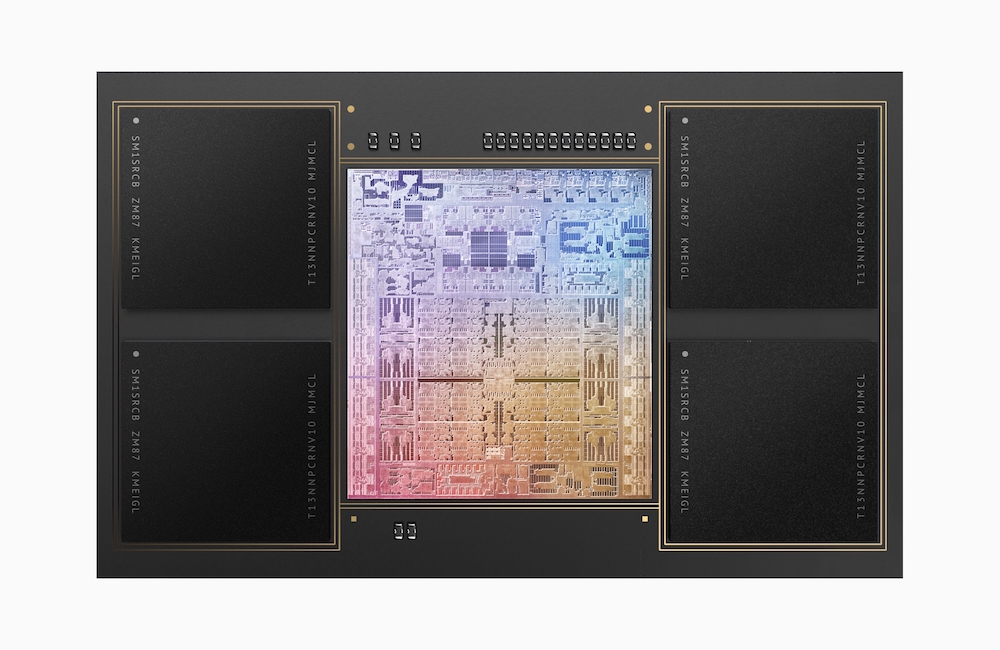
M1 Max chip - Image courtesy of Apple
Another change was the thickness of the new models. Apple had been on a quest (it seemed) to produce ever-thinner models in recent years, but this thickness, perhaps due to the design of the cooling airflow system, shows that this is a work machine not a fashion accessory. The MacBook Air can fulfil that role.
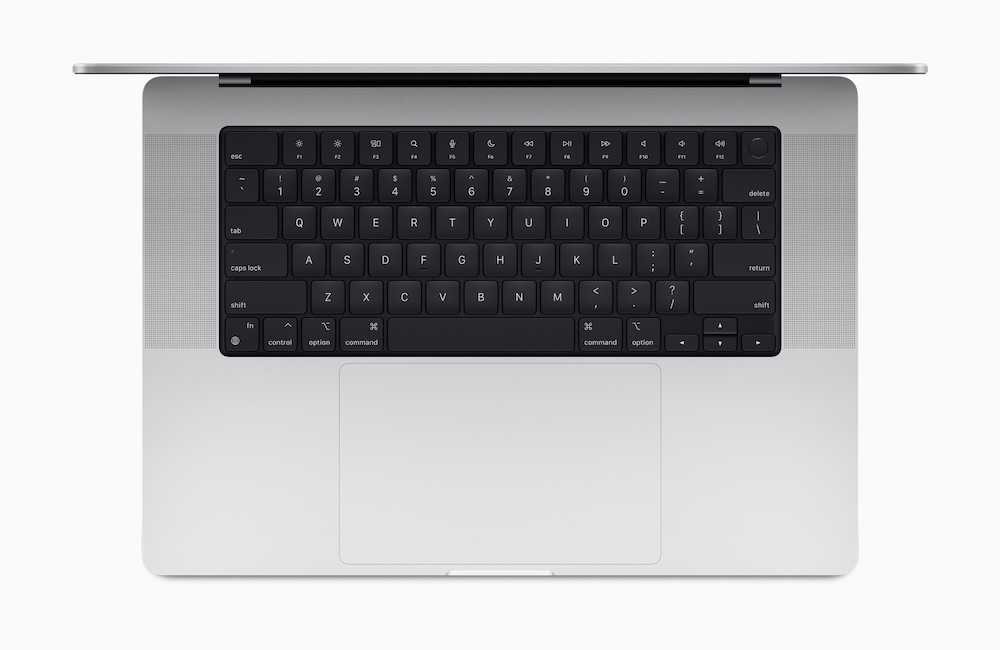
16-inch MacBook Pro and its keyboard - Image courtesy of Apple
AnandTechtech reported a while back that the architecture in the A-series and M-series chips is scalable, so Johny Srouji just keeps making them bigger. That equals more power, and incidentally, less power consumption, ergo better battery use. This makes some predictions about upcoming M1 chips relatively easy, although I would not want to second-guess Apple on the M2 (if that is its name) because this will not simply have more cores and better SoC features.
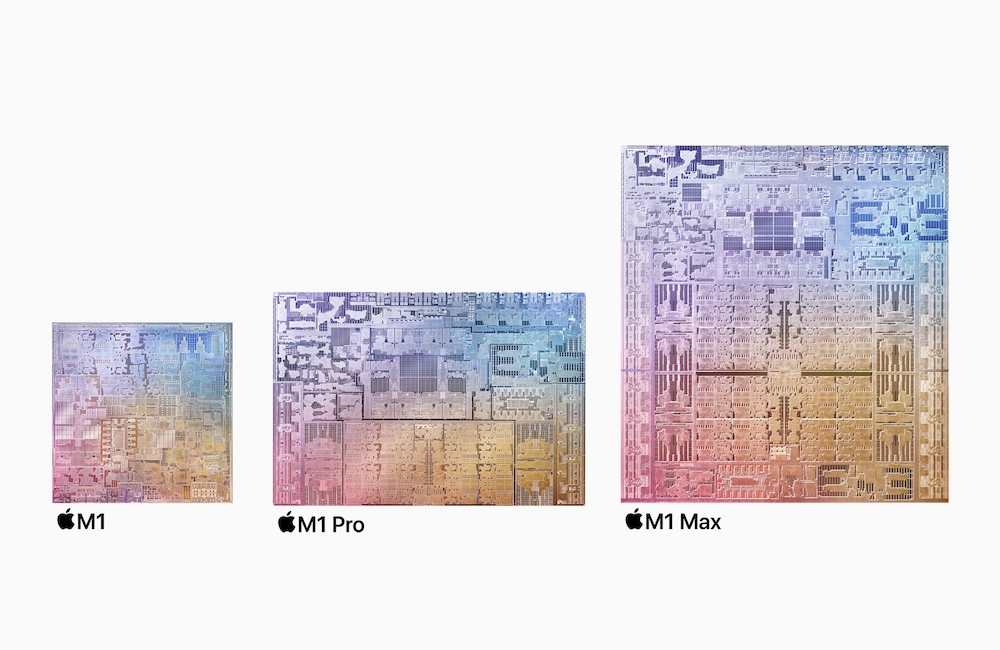
Current M-series chips - Image courtesy of Apple
With all of Apple's computers moving to Apple silicon this will need more. Srouji enlarges on this, and the decisions behind the development of Apple silicon in an interview (Wired - paywall) outlined in Patently Apple. The idea of scalability, which is mentioned a number of times in my comments, was built in right from the start.
I focused on some of the comparisons between the Pro and Max versions of the chips announced this week. The Pro DRAM has 200GB/s bandwidth, while the Max has 400GB/s; and the RAM that the respective versions can support is 32GB and 64GB while it was 16GB for the vanilla M1 chip. It does not take a genius to do the maths. The M1 chip had 16 billion transistors. The M1 Pro has 33.7 billion and the Max, 57 billion. It seems like only yesterday we were wowed by millions.
I was pleased to see Craig Federighi on camera for the MacOS section, although he seemed less dynamic than in his live performances at WWDC. I hope Apple does not go back to live delivery, except for its most important events as this delivery works for me, despite the tired-looking Federighi. The next version of macOS, Monterrey will be released on 25 October, so make sure those backups are up to date.
Back with John Ternus the new Macs were outlined. As well as the features above, it was revealed that there are 2 fans and a redesigned air-flow system to deal with any heat, although it was also explained that temperatures were lower than the earlier Macs. There is more information on the airflow system which is outlined by Sami Fathi (MacRumors) I do not think I have ever heard the fan on my Mac with the M1 chip and it certainly never feels warm; nor does the M1 iPad Pro for that matter. I could not exactly fry eggs on the previous Intel machines I had, but the fans did scream sometimes.
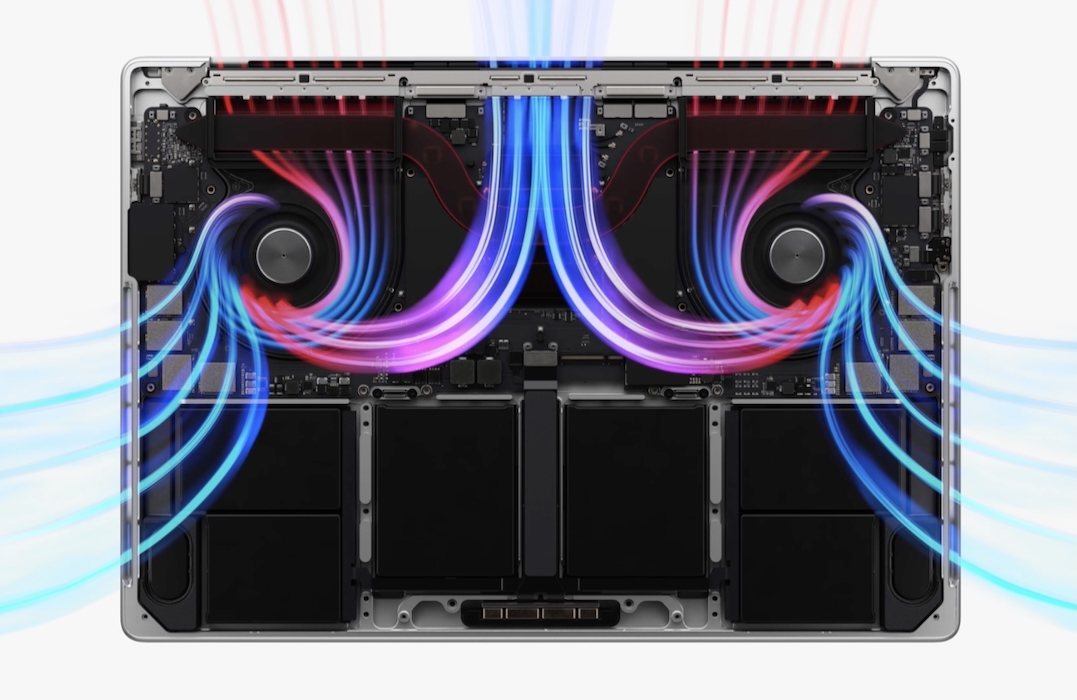
Screenshot of Air-flow in the latest Macs
Celebrating the dropping of Intel chips, MacDaily News called them anemic and inefficient. Coming a few hours after the comments from Intel CEO that he hoped Apple would one day return to Intel, it put that idea in perspective. As David Crewe (PetaPixel) comments, "By the time Intel does build a better chip, it is entirely possible that Apple has leapfrogged ahead to yet another unprecedented performance benchmark."
As a side note, running attack ads is not a way to endear yourself to a company you hope to re-enter a commercial relationship with. Others, like Bryan M. Wolfe (iMore) thought the new Macs were the stars of the show. The Pro and Max versions of the M1 chip also demonstrate that the scalability of these chips confirms, as has been expected since the A7, that Apple can build into its chips what it wants and not be left waiting for chip makers like Intel to reveal their designs, then produce the Macs around those limitations.
Other comments from Wolfe work for me as well, especially concerning the delivery of the slick video presentations, which are really marketing tools. Not only is this safer in the current situation, but it saves thousands of people traveling to California to report on the events. It will also save Apple much in terms of air fares and hotel charges for many, if not all of those journalists. I disagree with Wolfe about the end of the TouchBar. I liked it, but I will get over it when it comes to buying my next MacBook Pro: humans learn to adapt. Or not.
One aspect of the M-series is Apple's emphasis on the way that the power generation (GPU and CPU in the one chip) allows the computers to run far cooler. That was the problem with the G5 processor that prompted the move to Intel, and the slow pace of development at Intel was one of the factors that prompted Apple to develop its own.
As part of this, it is revealing to see just how well the M1 Max performs in relation to Intel's best. Juli Clover writing on MacRumors, reveals some benchmarking figures for single (1749) and multi-core performance (11542), which "outperforms all Mac chips with the exception of the Mac Pro and iMac models equipped with Intel's high-end 16 to 24-core Xeon chips." And we know that as Apple is developing Apple silicon that there is more to come. As one comment on the article notes, if the Intel chip performed like this, it "would melt through legs like butter" [sic].

16-inch MacBook Pro running XCode - Image courtesy of Apple
However, not long after reading that on MacRumors, I saw an item on Seeking Alpha (a financial site) that irked me somewhat. Arne Verheyde thought that the M1 Max was less impressive than it looks, and I was interested in how this conclusion could be drawn so soon after the event. The claim was that this new chip would not be as fast as a future Intel product (that may well be true of course). For his technical insights he referred to AnandTech which is an approach I often take: a trusted source. However, after comparing the desktop Alder Lake to the note book M1 Max, he argues that rather than the AnandTech view that this is a novel development, he thinks that this is "not a virtue, but a deficit." This seemed to be cherry-picking. At every point, the article sought to belittle the achievement here and laud Intel.
I waded through the whole article (getting more angry as I read) and it was not until I began to read the comments that the penny dropped. Many of those referred to Verheyde as an Intel troll. So the article needs to be examined in the context of that bias. Or simply dismissed. I was reminded of another Seeking Alpha contributor who was always negative on Apple and never gave positive advice on investment. Fortunately, those making comments were wise to him - like Verheyde - and were suitably derisive.
The increase in the number of cores in the M1 Pro and M1 Mac bodes well for the future and the obvious future release of a MacPro. This should not be a single chip offer, though. As with previous versions of the Mac Pro users will need different configurations of processors and the ability (at least) to increase RAM. Most Macs currently have fixed RAM that is decided by the user when buying the device new: RAM can be added at a price but cannot be changed afterwards.
It is widely reported that the SD card slot allows speeds up to 312MB/s although another report from Joe Rossignol (MacRumors) that has several useful performance details of the new Macs, claims that SD cards are limited to 250MB/s. This slot would not help me as I use a CFX card with the Nikon D850. The camera does have a slot for the SD card as well, but most of the time I connect the camera to the MacBook Pro or iPads (including the iPad mini) directly with a USB-micro to USB-C cable.
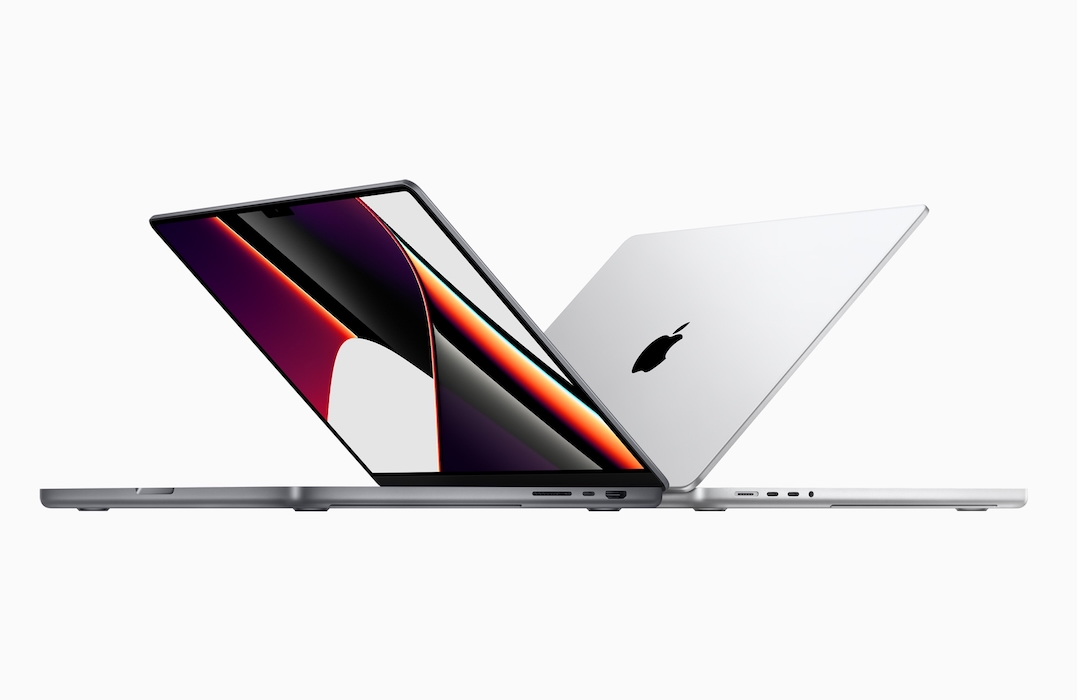
MacBook Pro 14 and 16-inch models - Image courtesy of Apple
I was discussing the new prices with a student who has the same M1 Mac as me. We agreed that the current device was enough for now, but what temptation these new devices are. I did notice one report (Sami Fathi, MacRumors) that showed Apple was offering a $1000 trade-in for those who had bought the first M-series Macs and were interested in these new ones. This is part of its normal trade in offer that Apple runs. The actual sum might depend on condition. If that discount of about 30,000 baht is offered here that would be worth considering for someone who needed a more powerful Mac. I cannot see that option on the Apple Store page for Thailand, but that may be visible when the Add to Bag button goes live.
I paid 56,900 baht for my M1 MacBookPro (I added RAM bringing it up to 16GB). The basic (I write that with tongue firmly in cheek) 14" M1 Pro device with 16GB RAM, 8-core CPU and 14-core GPU is shown as 73,900 baht (no delivery dates as yet). The 14" M1 Pro device with 10-core CPU and 16-core GPU is shown as 89,900 baht. The processors in these can be upgraded, with the M1 Max shown as an additional 23,000 baht. The three 16" MacBook Pro computers are priced at 89,900 (10-core CPU and 16-core GPU, 512GB SSD), 96900 (10-core CPU and 16-core GPU, 1TB SSD), and 124,900 baht with M1 Max (10-core CPU and 32-core GPU, 32GB RAM 1TB SSD). That can have up to 8TB storage (+77,000 baht) and an additional 32GB RAM (+14,000).
Graham K. Rogers teaches at the Faculty of Engineering, Mahidol University in Thailand. He wrote in the Bangkok Post, Database supplement on IT subjects. For the last seven years of Database he wrote a column on Apple and Macs. After 3 years writing a column in the Life supplement, he is now no longer associated with the Bangkok Post. He can be followed on Twitter (@extensions_th)
|










